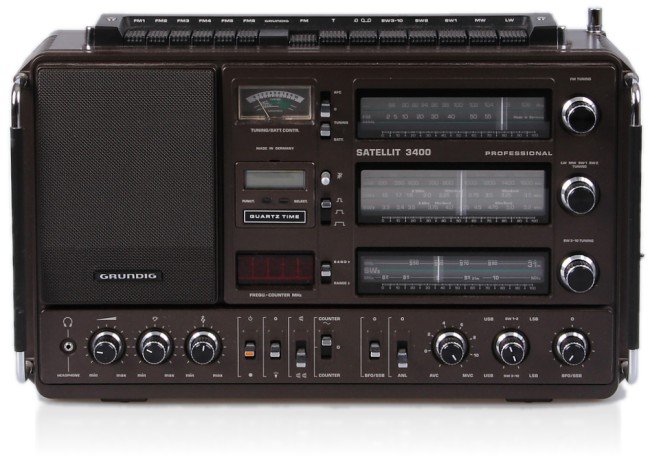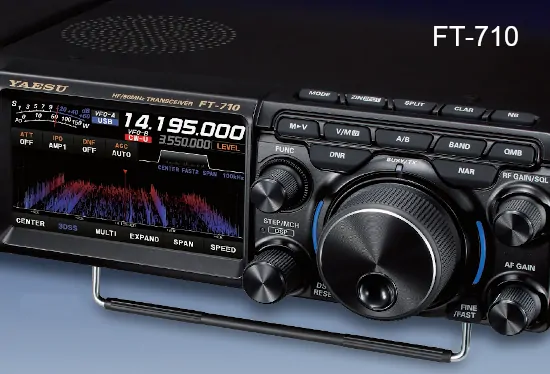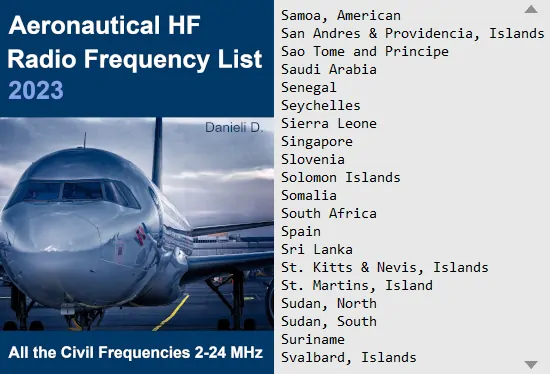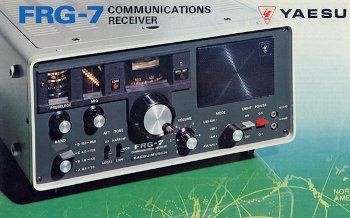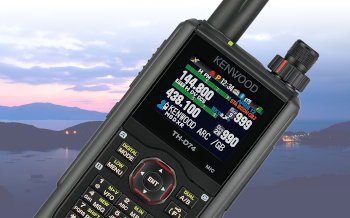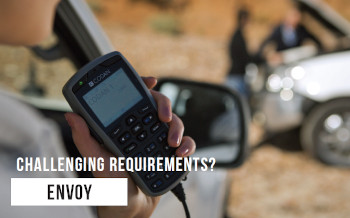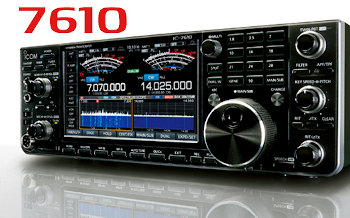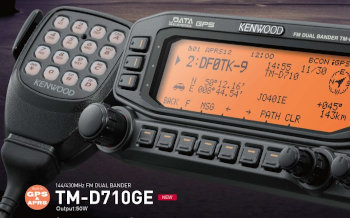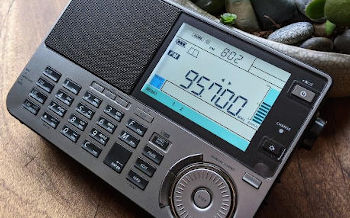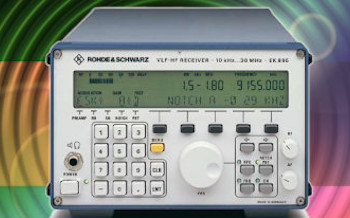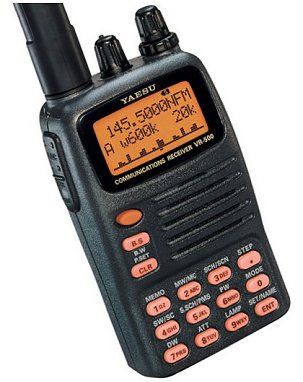
High RF sensitivity handheld scanner, receiving frequency range 0.1-1300 MHz all-mode. It features a band scope function and a easy user interface. Ideated in Japan, year of introduction 199x.
Reference market : amateur-radio
VR-500 specifications
| General |
| Frequency coverage | |
|---|---|
| 0.1000 ~ 1299.9995 MHz | |
| Mode | |
| CW / LSB / USB / AM / FM / WFM | |
| Tuning step | |
| 0.05 / 0.1 / 1 / 5 / 6.25 / 9 / 10 / 12.5 / 15 / 20 / 30 / 50 / 100 KHz |
| Receiver |
| Sensitivity | |
|---|---|
| SSB / CW | 0.6 uV (0.1~5 MHz, 10dB S/N) 0.5 uV (5~520 MHz, 10dB S/N) 0.8 uV (520~1300 MHz, 10dB S/N) |
| AM | 1.5 uV (0.1~5 MHz, 10dB S/N) 1.0 uV (5~370 MHz, 10dB S/N) |
| FM | 0.5 uV (5~520 MHz, 12dB SINAD) 1.2 uV (520~1300 MHz, 12dB SINAD) |
| WFM | 1.5 uV (5~370 MHz, 12dB SINAD) 1.8 uV (370~520 MHz, 12dB SINAD) 3.0 uV (520~1300 MHz, 12dB SINAD) |
| Selectivity [1] | |
| SSB | 7 KHz (-6dB) |
| FM | 18 KHz (-6dB) |
| WFM | 260 KHz (-6dB) |
| RF attenuator | |
| 20 dB | |
| Features |
| Memory | |
|---|---|
| 1000 regular memories in 10 banks 100 for skip in scan 10 for dual-watch 10 for programmed scan limits 1 priority channel |
|
| Display | |
| 100 Hz frequency resolution 10-segments signal meter bar 60-segments bandscope bar |
|
| Antenna | |
| BNC 50Ω | |
| Power supply | |
| 2.2 ~ 3.5V batteries, 3V nominal (2 x AA) 9 ~ 16 VDC external, center positive |
|
| Power consumption | |
| 115 mA typ 55 mA squelch On, battery save function Off 15 mA squelch On, battery save function On |
|
| Audio power | |
| 125 mW with external power supply 90 mW with batteries |
|
| Audio output | |
| Jack 3.5 mm |
| Mechanical and environmental data |
| Operating temperature | |
|---|---|
| from -10°C to +50°C | |
| Dimensions | |
| 58 (W) x 95 (H) x 24 (D) mm, without projections | |
| Weight | |
| 220g with batteries and antenna |
- This parameter, not in official data, was obtained with direct tests.
The Yaesu VR-500 is a compact portable scanner with many useful functions and at the same time easy to operate. Allows the tuning to be set via rotary control, 20 steps per revolution, or with direct input from the keyboard. Coaxial to the tuning command is the squelch adjustment. Different search options: between band limits also with automatic storage of active channels, within the memories according to mode / preferences, free from VFO to rise / lower than the starting frequency. The latter requiring no programming, is as simple as it is effective. To facilitate the recognition of the individual memory locations, an alphanumeric label up to 8 characters long can be associated with the frequency. Alternate (non simultaneous) dual-watch listening and monitoring of a priority channel give flexibility to listening needs. The spectral panoramic analyzer instead allows to visualize the radio activity in two operative forms: In the "A" mode a fixed interval of 300 KHz (± 150) or 600 KHz (± 300) is covered independent of the tuning step. In "B" mode 60 adjacent channels (± 30 CH) are covered with total interval according to the tuning step as in the following table.
| Step | Frequecy range |
|---|---|
| 50 Hz | 3 KHz |
| 100 Hz | 6 KHz |
| 1 KHz | 60 KHz |
| 5 KHz | 300 KHz |
| 6.25 KHz | 375 KHz |
| 9 KHz | 540 KHz |
| 10 KHz | 600 KHz |
| 12.5 KHz | 750 KHz |
| 15 KHz | 900 KHz |
| 20 KHz | 1.2 MHz |
| 25 KHz | 1.5 MHz |
| 30 KHz | 1.8 MHz |
| 50 KHz | 3 MHz |
| 100 KHz | 6 MHz |
The indication that appears on the display is proportional to the intensity of the signals, a marker manageable with the rotary control can be moved to one of the displayed emissions so that by disabling the analyzer the receiver automatically tunes this frequency. When the analyzer is active, normal reception is disabled. Given the wide range of memories, their structure and the many settings, programming is also possible using a PC, the programming kit (ADMS-3) with software and interface cable meets this requirement.
VR-500 performance and practical notes :
The behavior in SSB mode on bands below 30 MHz is appropriate for an device of this category. Emitters not interfered by adjacent signals are demodulated with clear audio making it possible to follow the utility radio traffic both in voice and in digital encodings. The bandwidth is determined by the IF filter dedicated to AM listening, for practical purposes this implies that the receiver is not able to really distinguish between LSB / USB. This limitation is intrinsic to the circuit configuration adopted and is also typical of portable scanners basically made for AM and FM listening.
The sensitivity with the supplied antenna is good both in VHF (low-band around 70 MHz, high-band around 160 MHz) as in UHF, since the same antenna has a poor performance on VHF the front-end of the receiver is correctly sized on a wide range of frequencies. The generation of intermodulations due to saturation in the RF stage is manifestly evident when there are strong signals, but this susceptibility is similar if not less than that found in other portable receivers. A similar consideration is given to the rejection of the image frequencies which, however, in ordinary use rarely give rise to real inconveniences.
The presence of spurious, that is signals generated by the same radio that appear as fixed carriers, is rather reduced. This aspect is relevant as it would degrade the scanning functions. We performed a test to measure the frequencies and amplitude of spurs that fall in the bands between 108-174 MHz and 430-440 MHz, the most important for the user. With the scanner in narrow-band FM mode and with 12.5 KHz steps, the entire frequency range has been tuned manually. The squelch has been left open so as to check the presence of even the weakest components. Following the complete list of channels where spurious appear:
| Channel / Presence | |
|---|---|
| 125.1375 MHz | only background noise increase |
| 125.2000 MHz | only background noise increase |
| 130.5500 MHz | only background noise increase |
| 130.7500 MHz | only background noise increase |
| 132.3500 MHz | only background noise increase |
| 453.9500 MHz | signal at level 4 on S-meter |
| 453.9875 MHz | signal at level 7 on S-meter |
| 454.0500 MHz | signal at level 3 on S-meter |
| 454.0875 MHz | signal at level 7 on S-meter |
| 459.3625 MHz | only background noise increase |
| 459.4625 MHz | only background noise increase |
| 461.1750 MHz | only background noise increase |
| 461.2750 MHz | only background noise increase |
| 462.5500 MHz | only background noise increase |
| 463.3000 MHz | only background noise increase |
| 466.1375 MHz | only background noise increase |
| 466.9375 MHz | only background noise increase |
| 467.0375 MHz | only background noise increase |
| 468.3500 MHz | signal at level 3 on S-meter |
| 468.3625 MHz | signal at level 7 on S-meter |
| 468.4000 MHz | only background noise increase |
| 468.4250 MHz | only background noise increase |
Overall, the result is certainly better than the average of handheld scanner. For completeness we specify that the tests were performed first by connecting a small 50 Ω load to the input and then with the supplied antenna. The double test was used to check the origin of the signals by removing all the uncertainties.
VR-500 price
We have collected for your convenience the Yaesu VR500 sale price (US Dollar) and its trend over time. Useful to guarantee a cheaper purchase of this radio and to put it for sale in the second-hand market. Of course offers, accessories, warranty terms and conditions can lead to different figures.
|
|
|
|
|
USD 180.00 (139GBP) |
2020-jan | Second Hand |
|
USD 231.00 (199EUR) |
2020-jan | Second Hand |
| USD 299.00 | 2020-jan |
Second Hand In excellent shape and working conditions. With no dents or scratches at all, no dead pixels on diplay |
VR-500 review
| Sensitivity | |
| Selectivity | |
| Dynamic range | |
| Spurious response | |
| Audio | |
| Signal functions | |
| Control functions | |
| User friendly | |
| Stars: 1=insufficient | 2=just sufficient | 3=mediocre | 4=good | 5=excellent | |
| Tamas | July-4 2023 |
Hello!
I bought a VR-500, but at 500 MHz there is already a 12 KHz difference down from the original frequency. Is this repairable or aging? A very enjoyable little radio. Greetings.
[End post]
| SWL118 | June-18 2023 |
Hello,
Since I had the VR500 receiver comparing it with the Kenwood TH-F7 I can say that in SSB on the HF bands it proves to be little or not even sufficient. On the other hand, I was able to hear signals with the TH-F7 that the 500 did not receive. After 1 month I resold it!
[End post]
| Dave Freestone |
I had this good little scanner for 15 years before it decided to pack up. The reception was incredible, I used it mostly for airband and short-wave reception. Combined with the antennas I had in my attic, and the use of external speakers, I managed to track an aircraft all the way from Heathrow to 40 miles east of Frankfurt. The Channel separation is excellent, no bleed over. A good solid radio.
[End post]
Your opinion on merits, defects, experiences, with this radio set is welcome. Write your review, after a technical evaluation by our staff if found suitable will be published on this page. We thank you for your precious contribution.
